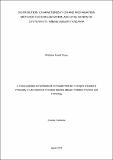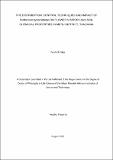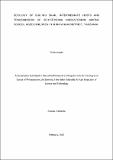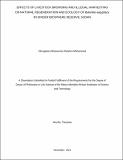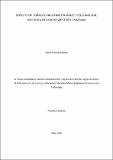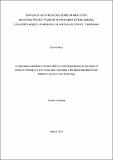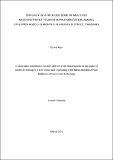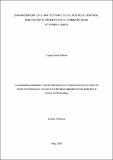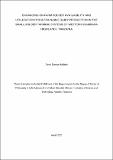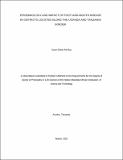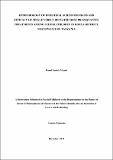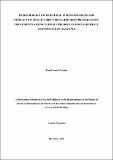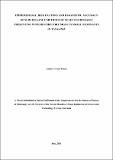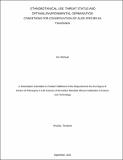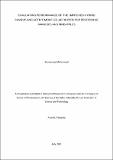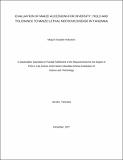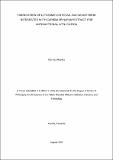Browsing PhD Theses and Dissertations [LiSBE] by Title
Now showing items 35-54 of 92
-
Dietary Practices, Nutritional status, Risk of exposure to aflatoxins and Pesticide among adolescents in Boarding - high schools in Kilimanjaro, Tanzania
(NM-AIST, 2023-08)School feeding in low income countries relies mainly on cereals and legumes. Cereals are low in nutrients and its overdependence can lead to poor nutrient intake. Cereals and legumes are susceptible to aflatoxins ... -
Distribution, characterization and propagation methods for conservation and utilization of oyster nuts telfairia pedata in Tanzania
(NM-AIST, 2023-04)Oyster nut (Telfairia pedata) is a native East African climber, growing naturally or planted in association with tall trees Tanzania (including Zanzibar island), Kenya and Uganda. Plot less sampling method within different ... -
The distribution, control techniques and impact of Parthenium hysterophorus on flower visitors and soil chemical properties in Meru district, Tanzania
(2020-08)In Tanzania, the invasive plant Parthenium hysterophorus threatens natural and semi–natural environments. Little is known about how this species affects plant–pollinator interactions and soil–chemical properties. Roadside ... -
Ecological effects of selected invasive plants and their nature based management approaches
(NM-AIST, 2017-12)Biological invasions are one of the major threats to most ecosystems as they often suppress native plant species. This suppressive effect is usually costly and irreversible hence calling for effective management strategies ... -
Ecology of bulinid snail intermediate hosts and transmission of schistosoma haematobium among school aged children in Shinyanga district, Tanzania
(2020-02)This study investigated transmission of Schistosoma haematobium through longitudinal parasitological, malacological and human water contact surveys. Urine samples collected from school children were examined for S. ... -
Effects of livestock browsing and illegal harvesting on natural regeneration and ecology of balanites aegyptiaca in dinder biosphere reserve, Sudan
(NM-AIST, 2021-11)Livestock browsing, and illegal harvesting often influence natural woodlands, rangelands, and biosphere reserves. However, the resulting tree species diversity, composition, and population structure have rarely been ... -
Effects of tobacco nicotine on maize yield and soil bacteria in Tabora western Tanzania
(NM-AIST, 2020-05)Tobacco (Nicotiana tabacum L.) is globally known to be a primary source of nicotine worldwide. This study was conducted to determine the effects of nicotine on the rhizosphere and subsequent maize crop yield. Pot experiments ... -
Efficacy of a reduced dose of multiple micronutrient powder supplementation among children aged 6-59 months in Arusha district, Tanzania
(NM-AIST, 2019-03)Iron deficiency anaemia is the most prevalent nutritional problem affecting children underfive years old in the developing countries. The deficiency is a result of inadequate intake and insufficient absorption of iron-rich ... -
Efficacy of a reduced dose of multiple micronutrient powder supplementation among children aged 6-59 months in arusha district, Tanzania
(NM-AIST, 2019-03)Iron deficiency anaemia is the most prevalent nutritional problem affecting children underfive years old in the developing countries. The deficiency is a result of inadequate intake and insufficient absorption of iron-rich ... -
Enhanced one Health surveillance approaches to guide the elimination of dog-mediated rabies in Tanzania
(NM-AIST, 2023-08)Rabies causes approximately 59 000 human deaths worldwide annually. A global target of zero human deaths from dog-mediated rabies has been set for 2030, and large-scale control programs are now advocated. However, there ... -
Enhancement of plant extracts use for pest control and growth promotion of common bean (Phaseolus vulgaris)
(NM-AIST, 2020-05)For smallholder farmers, suitable plants for pest management and as foliar feed are obtained with ease, and when successfully exploited, could contribute to local income generation through commercialization. However, ... -
Enhancing on-farm fodder availability and utilization for sustainable dairy production in the smallholder farming systems of western usambara highlands, Tanzania
(NM-AIST, 2020-04)Dairy cattle farmers in Tanzania experience a huge decline in milk production due to insufficient feed supply to their animals particularly during the dry seasons. This poses a great challenge to sustainability of ... -
Epidemiology and impact of foot-and-mouth disease in districts located along the Uganda and Tanzania border
(2020-03)The Uganda-Tanzania border area lies within the main risk areas for foot-and-mouth disease (FMD) circulation. With the introduction of the progressive control pathway for FMD in eastern Africa, reliable information on ... -
Epidemiology of intestinal schistosomiasis and efficacy of single versus repeated dose praziquantel treatments among schoolchildren in Rorya district, Northwestern Tanzania
(NM-AIST, 2018-12)In Schistosoma mansoni endemic areas, administering repeated treatments may increase praziquantel cure rate (CR) and egg reduction rate (ERR), thereby improving morbidity reduction and hastening achievement of transmission ... -
Epidemiology of intestinal schistosomiasis and efficacy of single versus repeated dose praziquantel treatments among schoolchildren in Rorya district, Northwestern Tanzania
(NM-AIST, 2018-12)In Schistosoma mansoni endemic areas, administering repeated treatments may increase praziquantel cure rate (CR) and egg reduction rate (ERR), thereby improving morbidity reduction and hastening achievement of transmission ... -
Epidemiology, risk factors and diagnostic accuracy of surveillance methods of selected diseases presenting with respiratory signs in small ruminants in Tanzania
(NM-AIST, 2021-07)Outbreaks of diseases presenting with respiratory signs in small ruminants in Tanzania have been reported for years. Concurrent infections complicate diagnosis resulting in untimely interventions and significant economic ... -
Ethnobotanical use, threat status and optimalenvironmental germination conditions for conservation of aloe species in Tanzania
(NM-AIST, 2022-09)The genus Aloe is known for its use in healthcare and cosmetics. Many Aloe species are globally threatened due to over-harvesting for trade and habitat destruction. In Tanzania, over-exploitation threats some Aloe species ... -
Evaluating performance of the improved hybrid passive and active mode solar dryers for processing Mangoes and Pineapples
(NM-AIST, 2021-07)Farmers in East Africa have no access to modern processing technologies because they are costly and high-energy demanding to operate. As a result, they solely rely on the traditional open sun drying (OSD) method, which ... -
Evaluation of maize accessions for diversity, yield and tolerance to maize lethal necrosis disease in Tanzania
(NM-AIST, 2017-12)Maize (Zea mays L.) is among the most important crops in Tanzania with still low average yield of 1.2 metric tonnes per hectare as compared with potential yields of 4 to 5 metric tonnes per hectare. Low yield is due to a ... -
Fabrication of liposome-chitosa N-ZnO nanohybrid integrated with Carissa Spinarum extract for antibacterial application
(NM-AIST, 2023-08)Innovative biomaterials provide a stimulating and adaptable platform for the implementation of new and more effective methods to prevent bacterial infection. Built on biomimetic inorganic hybrid material, Dual Nanohybrid ...


